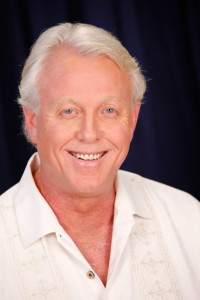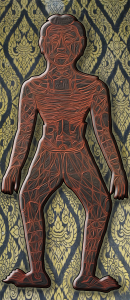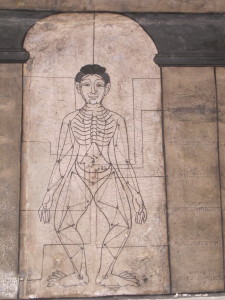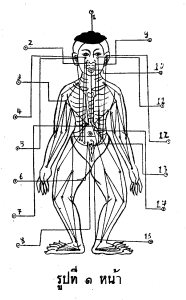Thai Traditional Massage Sen Lines
By Anthony B. James DNM(C), N.D. (T), M.D. (AM), DPHC(h.c.), DOM, RAAP, SMOKH Academic Dean SomaVeda College of Natural Medicine and Thai Yoga Center (SCNM). Buddhai Sawan Institute Gold Sash/ Ajahn.
What are Thai Traditional Massage Sen Lines?
Sen is the Thai word for the line. It is the same concept as Prana Nadi used in Yogic terminology, and the terms are interchangeable. The Sanskrit word Nadi means stream or movement. Sip Sen is considered an energetic pathway of the life-giving breath in the body. The oldest traditional yogic texts are reputed to refer to the existence of 350,000 lines. These lines form the Matrix, Energetic, or Prana Maya Kosha’s body.
As recently as two thousand years ago, specific references alluded to as many as 72 000 of these lines. This makes common sense. If the Lines are how life energy is distributed through our being and body, then every part of us would need a way to receive this energy. So more likely, there are billions of lines.
Become a Certified SomaVeda® Thai Yoga Practitioner or Therapist Today! Click here!
Phraa Wat Chetuphon Epigraphies: The earliest known references to them in Thailand’s traditional medicine is found on Phra Wat Chetuphon, more commonly known as Wat PO, in Bangkok. This record appears as a series of actual stone carvings called the “Medical Texts, which His Majesty King Rama III had engraved at Phra Chetuphon in B.E. 2375 (AD 1832)”. These were commissioned public works based on older original Thai Traditional Medicine Codex.
Two types of Sen: Subtle and Gross (Pranavaha and Manavaha Nadi):
Sen is Prana Nadis, or energetic pathways of the life-giving breath in the body. These lines form the matrix or active body. In Ayurveda, this body is called the Pranamaya Kosha.
These pathways correlate and communicate with each other. Their nexus of communication are the chakras, significant concentrations, or energy vortices. The Sen lines move this energy to the various individual parts of us. They also flow through minor chakras called by many names; Lom or wind gates, Marma, Muladra, Granthis, knots, and acupuncture points.
Upon inspection, we find many of these knots to be the same points used in traditional acupuncture. Many also correspond with the specific location of trigger points.
In the traditional literature of Thailand, an Indian-born Tibetan Yogic Doctor or Physician named Father Shivago Komolaboat (Jivaka) is credited with distilling the theory of 72 000 lines into ten primary lines. The Thais call these ten lines Sip Sen. In Shivago’s day; it commonly took 20 or thirty years for an apprentice doctor to become recognized as a physician. One of the reasons for this was simply the volume and the number of various concepts to be learned and memorized. If one had to discover thousands of lines, points, Chakra, etc., it would take many years. However, by distilling the “thousands, i.e., infinite” number to few, the time to function for the prospective physician was significantly reduced. For example, an interstate highway distills many surface streets into one or a few national highways.
Infinite lines!
There are not only 10 Sen Lines (Sip Sen). In some illustrations and or oral traditions, there are 72 000. In some depictions, as many as 350,000! If you consider the idea that every part of us needs this vital essence or life energy, and by every aspect, I refer not just to soft tissue planes (Myofascial Channels and or Trans-subcutaneous Muscular Channels- TSMs), organs, and skeleton but to every living cell then the more significant numbers as symbolic of infinity. Similar to the “Theory of Ten Thousand Things” in Traditional Chinese Medicine.
The three primary Sen (Tri-Se: Sumana, Ittha, Pingkala) develop in the embryo, and within eight weeks, all the main chakras and subtle nerves are formed. Sip Sen( or ten lines) generates, maintains, and corrects a harmonious body/ mind/ psyche state.
Chakras function on one level as cosmic windows facilitating an energy exchange between the human body and the universe. The various lines then move this energy to the individual parts of us. In theory, the ten lines generate, maintain and correct a harmonious balance or state in the body/mind/psyche, or spirit. Although responsive to the initial energy or stimulation from the chakras, the lines may also function to tune or assist the chakra function in turn. This picture is one of a reciprocal system. Moving, adjusting, stretching, or otherwise affecting the lines into particular relationships may, in turn, focus more or less energy or Prana to (or through) one or more specific chakras.
The Sen may also function to tune or to assist the chakra function. Think of a two-way transceiver. By moving the body into the various postures or Asanas, we change the relationships of the lines to each other. This may enhance or focus more or less energy on particular chakras. This concept sees the lines as a sort of antenna. Change the alignment of the antenna and get a better or a different picture.
If Chakra is the transformers and generating stations, then the Sen/ Nadi is the network and sub-nets of and for energy distribution.
What flows in the Sen?
The standard term is Lom or “Wind.” However, Lom is more than the elemental force. One “Thaat Thang Sii” is wind, breath, and vitality. Thai Ayurveda calls it Prana Yama, or the vital breath of life. It is the essence of spirit and life force. This essence or power is known in all cultures by names such as Taoist Qi, Chi, Ki, Huna (Mana), Elan Vital, Ka, Orgonne, Shakti, Holy Spirit, and African Ashe.
Sip Sen Line Names and Correlation with Classical Ayurveda concept of Prana Nadi
There is an almost exact correlation between classic Ayurveda (Tibet, India, Sri Lanka) and Thai Sen; most names are virtually identical. The significant difference is between Thai Pali and Classical Sanskrit. Each Sen follows a unique pathway exclusive to one side of the body. The Sen are divided into traditional categories of Sun / Moon, Male / Female alignment (Left side lines are Lunar/ female and Right side lines are Solar/ male). This could also be an indication of polarity.
In practice, the different traditional schools and specific regions place more or less emphasis on addressing the Sen Lines and also as to precisely how to do it! Some stress Thai Traditional Massage Sen lines over points and others points (Lom/ Marma) over the Sen. This can vary widely from school to school. The most significant variation is found in the western U.S. schools, where there is little education about traditional theories such as Sen Lines and, therefore, less or little clinical emphasis.
THAI PALI Sen Line Ayurveda: Sanskrit Prana Nadi
#1 SEN SUMANA (Core) SUSHUMNA (Rajas)
#2 SEN ITTHA (L. side) IDA (Tamas)
#3 SEN PINGHALA (R. side) PINGALA (Satvic)
#4 SEN KALATHARI (Core) VISHVODARA
#5 SEN SAHATSARANGSI (L) GHANDARI
#6 SEN THAWARI (R. side) HASTAJIVA
#7 SEN LAWUSANG (L. side) YASHASVINI (Female)
#8 SEN ULANGKA (Rucham) (R) PUSHA (Male)
#9 SEN NANTHAKRAWAT Kuhu
A) Sikhini B) Sukumang
#10 SEN KHITCHANNA Shakhini
A) Itaken B) Kitcha
Other systems with similar ideas
The Indian Ayurveda correlations have been discussed. There also appear to be correlations conceptually in different methods, such as Traditional Chinese Medicine Acupuncture. The nearest overlapping examples are in the Theory of TSMs or Trans-subcutaneous Muscular Channels. TSMs relate to the organs due to the more common meridians however are broad and general and appear to follow Fascial planes (Myofascial Channels or Chains).
The traditional Hawaiian Ho’omana/ Kahuna (Huna) Medicine also emphasizes pathways of life force which they term Cords. These cords flow within us and between us and the world around us.
Scientific research and Theory in support of Thai Traditional Massage Sen Lines (Energy pathways, vessels, conduits)
Additional sources and references suitable would be Alternative and Complimentary research into Electromedicine, Quantum Medicine, Primo Vascular System (PVS), Myofascial Muscle Channels or Chains, Krabi Krabong, Muay Boran and Muay Thai Traditional Thai Martial Arts.
- What is evidence-based about myofascial chains? A systematic review
- Exploring New Horizons in Electromedicine: Robert O. Becker. The Journal of Alternative and Complementary Medicine. February 2004, 10(1): 17-18. doi:10.1089/107555304322848904.
- Lines, Wheels and Points and Remedies: Anthony B. James, Meta Journal Press, Atlanta, Georgia 1983: ISBN 1-886338-08-6
- Ayurveda and Thai Yoga: Religious Therapeutics Theory and Practice by Ajahn, Dr. Anthony B. James
- Myofascial Meridians as Anatomical Evidence of Acupuncture Channels: Peter T. Dorsher. Medical Acupuncture. June 2009, 21(2): 91-97. doi:10.1089/acu.2009.0631.
- Traditional Alternative as Complimentary Sciences: The Case of Indo-Tibetan Medicine: Joseph J. Loizzo and Leslie J. Blackhall. The Journal of Alternative and Complementary Medicine. Fall 1998, 4(3): 311-319. doi:10.1089/acm.1998.4.3-311.
- Study on the meridian tropism of medicinal property theory for Chinese medicines by supramolecular chemistry
- Acupuncture Meridian of Traditional Chinese Medical Science: An auxiliary Respiratory System.
- Yoga Breathing for Cancer Chemotherapy-Associated Symptoms and Quality of Life: Results of a Pilot Randomized Controlled Trial: Anand Dhruva, Christine Miaskowski, Donald Abrams, Michael Acree, Bruce Cooper, Steffanie Goodman, and Frederick M. Hecht. The Journal of Alternative and Complementary Medicine. May 2012, 18(5): 473-479.
- Bio-Energetic Medicine: Scientific Evidence in Support of Acupuncture and Meridian Theory:
I. Introduction: Institute of Electrical and Electronics Engineers. Reprinted, with permission, from IEEE, ENGINEERING IN MEDICINE AND BIOLOGY Magazine, Volume 15, Number 3, May/June 1996. - The Flow of Qi: Metaphysical Metaphor or Physical Reality: Terry Oleson. Medical Acupuncture. September 2010, 22(3): 157-159. doi:10.1089/acu.2010.2018. doi:10.1089/acm.2011.0555.
- The Pimo Vascular System: New Research on a Half-Century-Old Idea: Richard C. Niemtzow. Medical Acupuncture. October 2013, 25(5): 309-310. doi:10.1089/acu.2013.2551.
- Will the Primo Vascular System Finally Solve the Mystery of Acupuncture?: McDonald Mark J.. Medical Acupuncture. February 2015, 27(1): 33-37. doi:10.1089/acu.2014.1075.
- Gross Anatomy and Acupuncture: A comparative Approach to Reappraise the Meridian System: Stefano Marcelli. Medical Acupuncture. February 2013, 25(1): 5-22. doi:10.1089/acu.2012.0875.
- Modern View of The Theory of Channels, Collaterals, and Organs: Mikhail Teppone and Romen Avakyan. Medical Acupuncture. March 2007, 19(1): 43-48. doi:10.1089/acu.2006.507.
For more information on educational materials by this author, see the bookstore at ( https://www.BeardedMedia.Com ). If you think your friends would benefit from this information, please have them subscribe to our newsletter!
For information on SomaVeda® Thai Yoga Practitioner Certification Program, Click Here!
Learn Traditional Thai Massage in Thailand! Join us for an authentic, genuine training and sacred tour in Thailand this June 2023!
Disclaimer:
All Information about Thai Traditional Medicine Sen Lines is provided as an opinion for educational purposes only. It is not intended to be used for any therapeutic purpose or to diagnose, prevent, treat, or cure any disease. It is not intended as a substitute for competent medical advice regarding any medical condition. Please consult a health care professional for diagnosis and treatment of medical conditions. At the same time, all attempts have been made to ensure the accuracy of this information. The author and ThaiMassage.Com do not accept any responsibility for any errors or omissions.
Copyright© 2015-2023, Anthony B. James, All rights reserved under International and Pan-American copyright conventions. World rights reserved. No part of this article may be reproduced or utilized in any form or by any means, electronic or mechanical, including photocopying and recording, or by any information storage and retrieval system, without permission in writing from the publisher. Inquiries should be addressed to Anthony B. James, 5401 Saving Grace Ln. Brooksville, FL 34602 · https://thaiyogacenter.com
SomaVeda Integrated Traditional Therapies®, SomaVeda® is a Federally Registered Trademark/ Servicemark and proprietary Intellectual Property, All World Rights Reserved.
This article about Thai Traditional Medicine Sen Lines is presented solely as an opinion for educational purposes. It is not intended as a substitute for competent medical advice regarding any medical condition. Please see your physician or qualified medical professional when considering any treatment for any disease.





